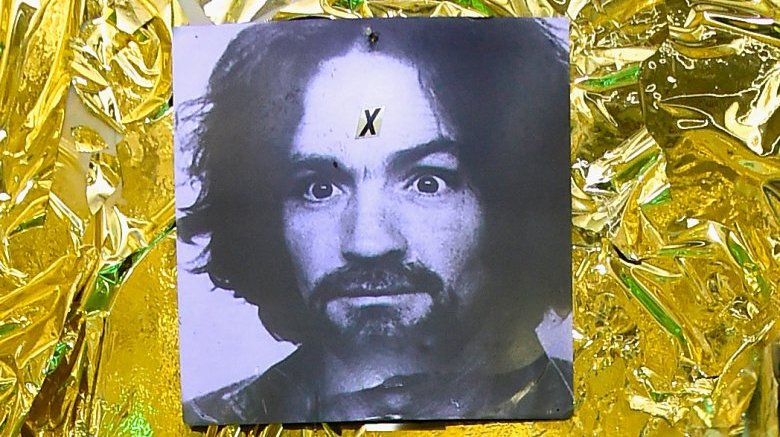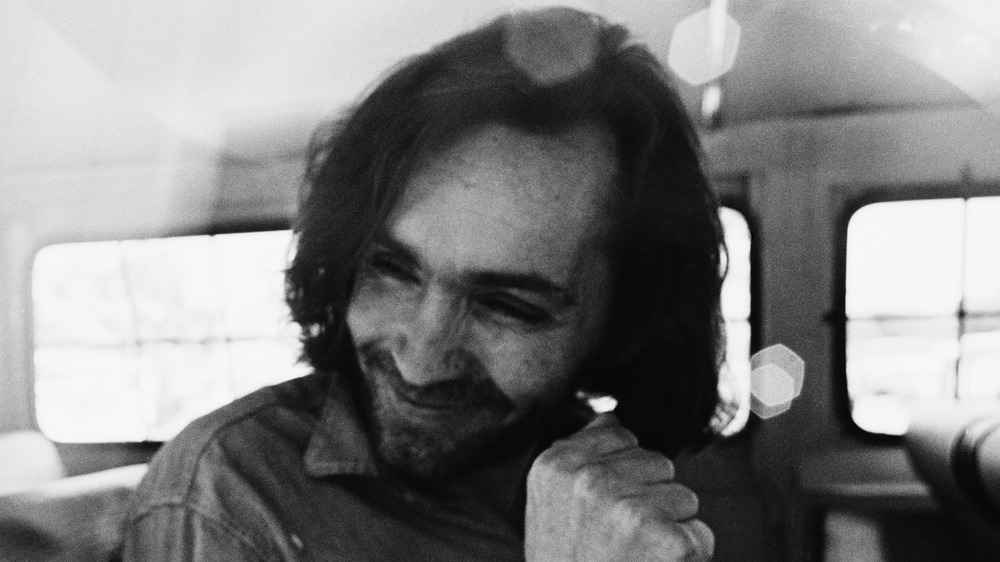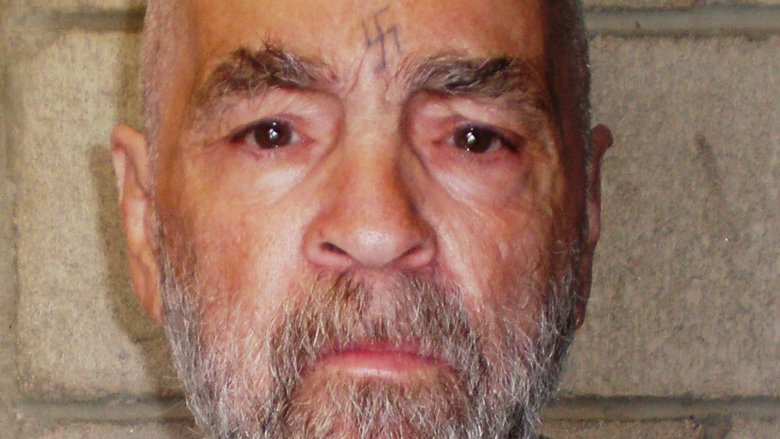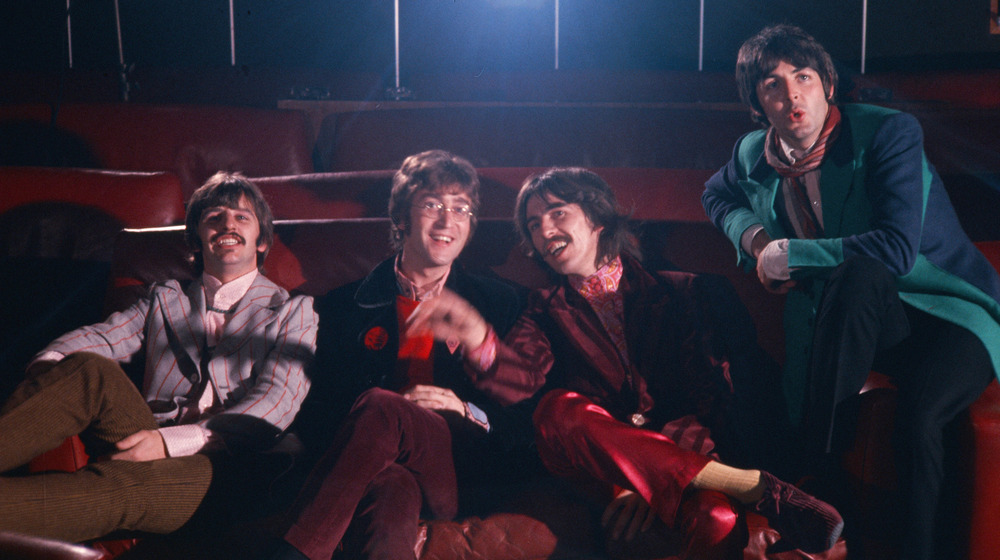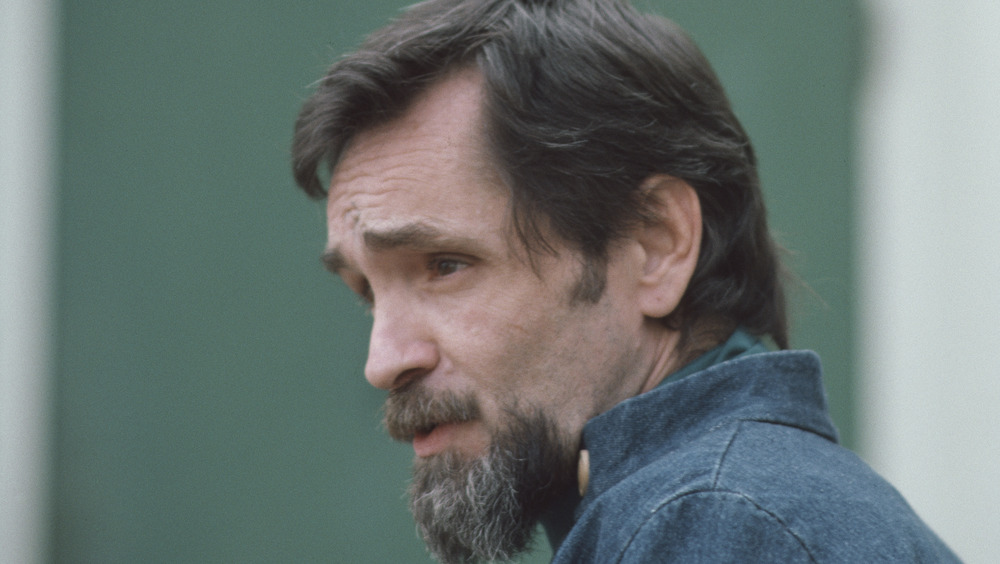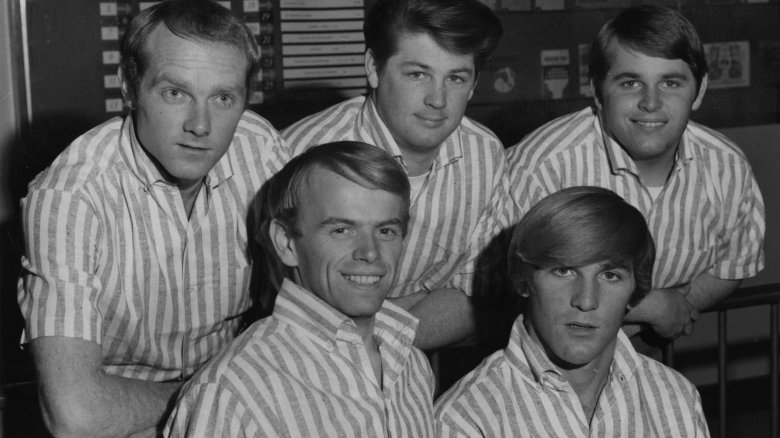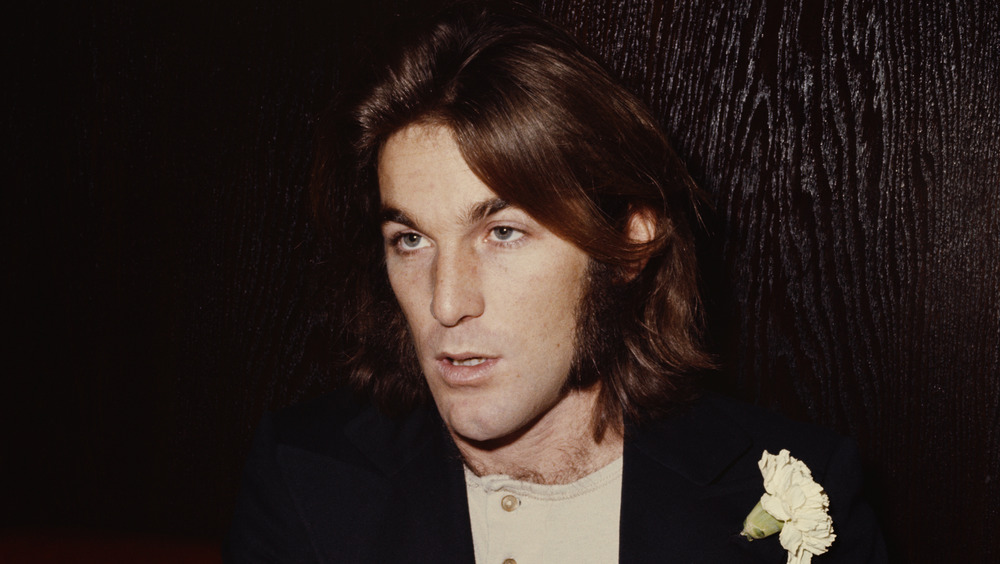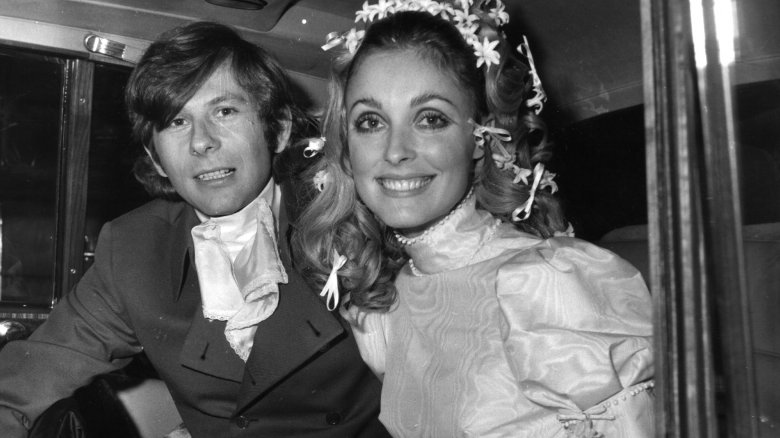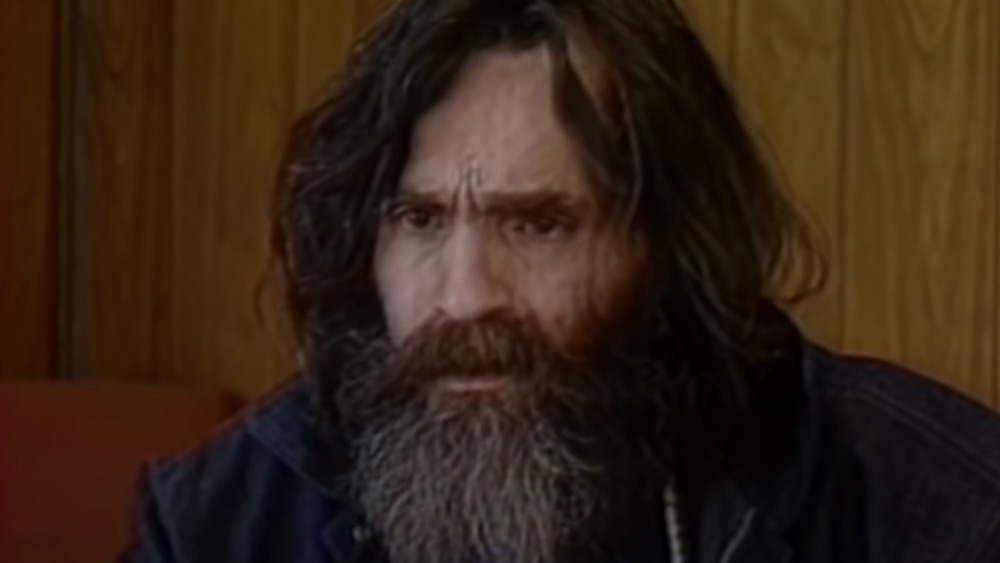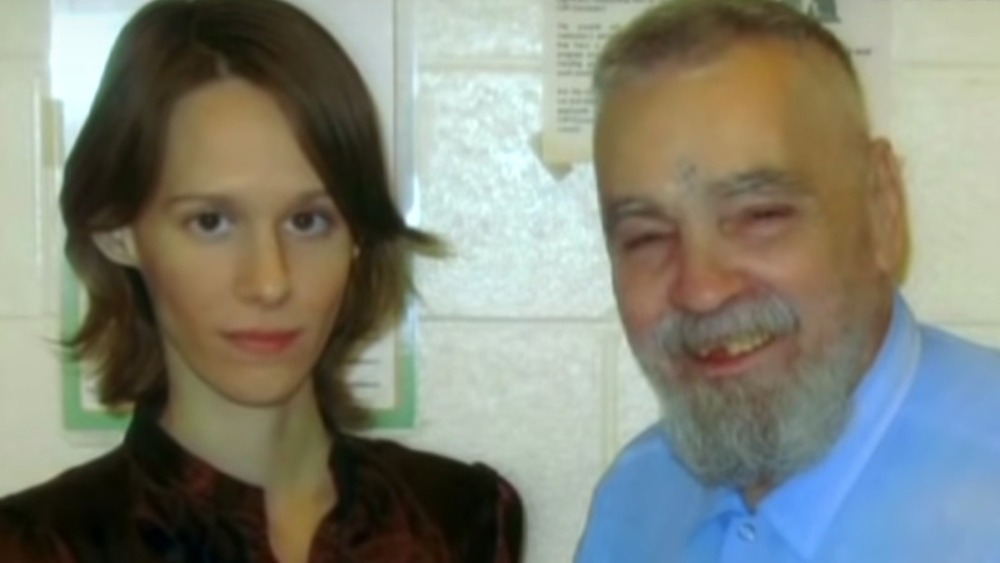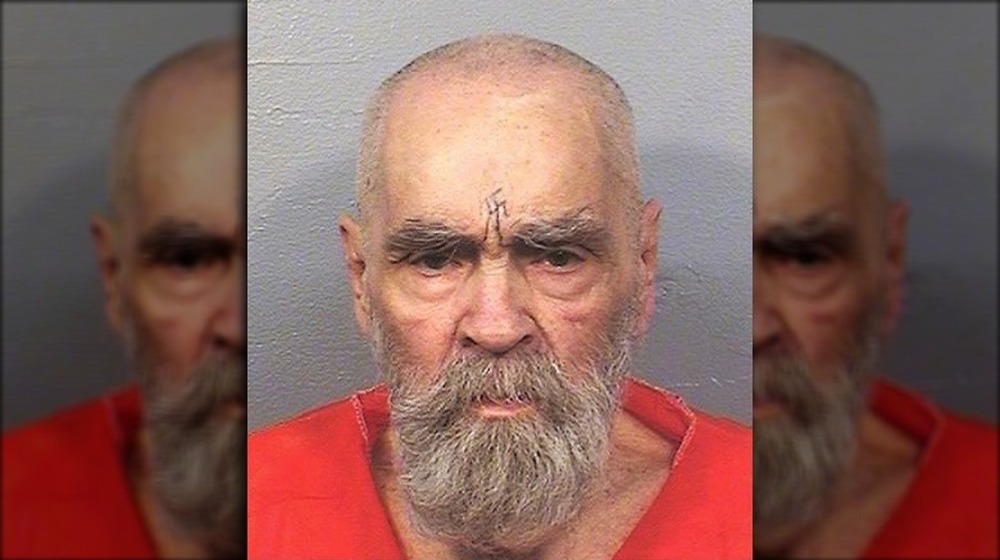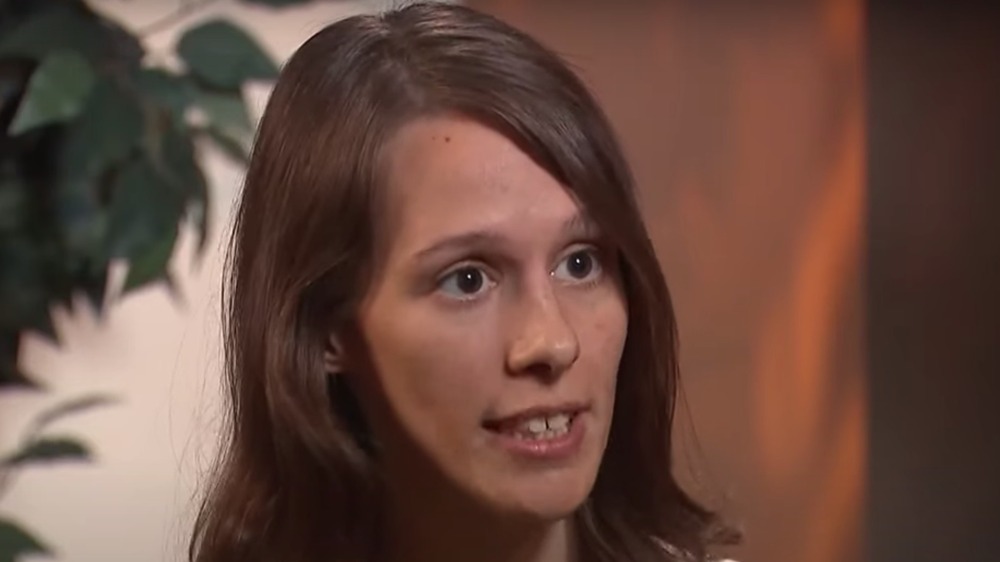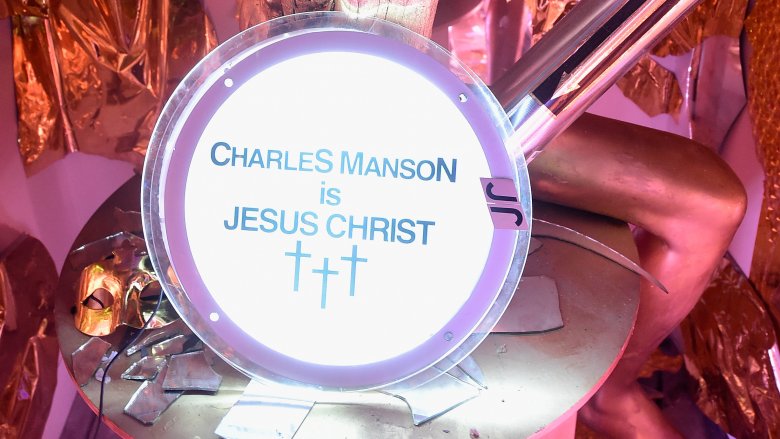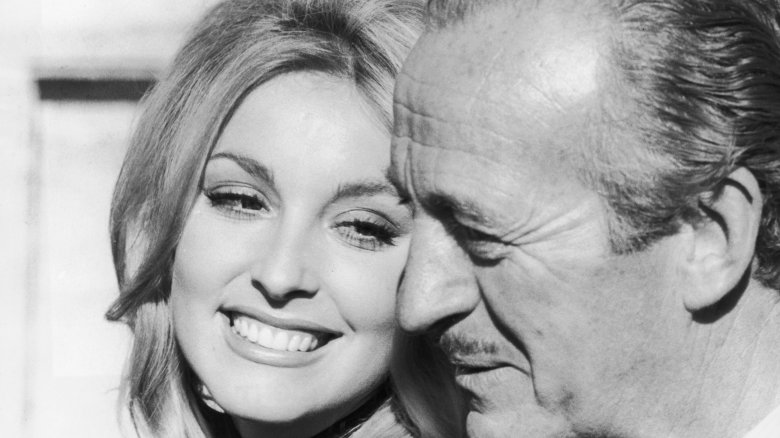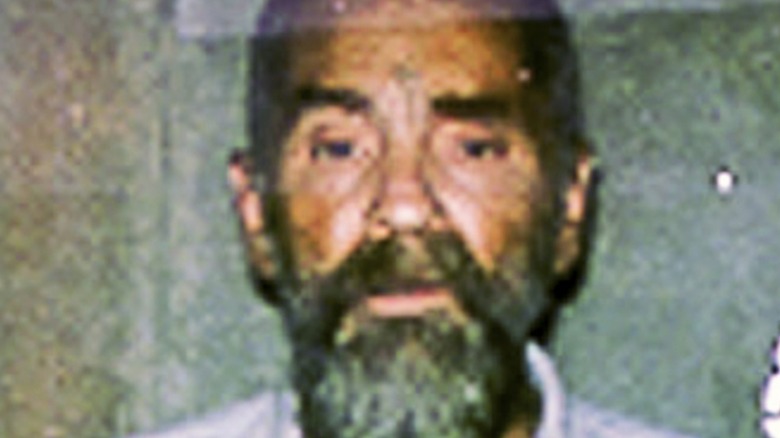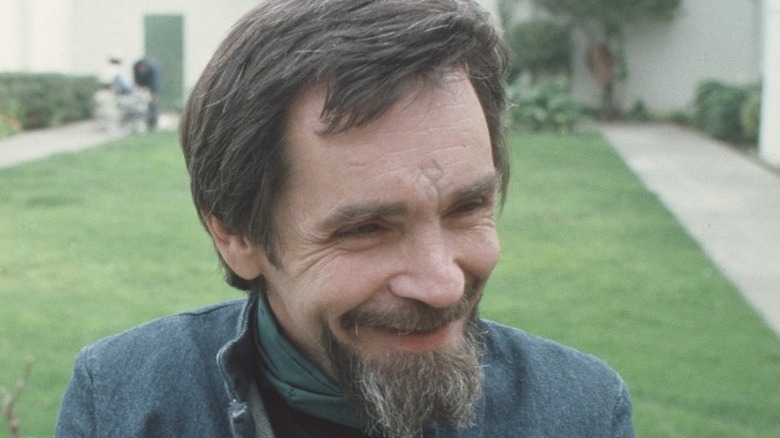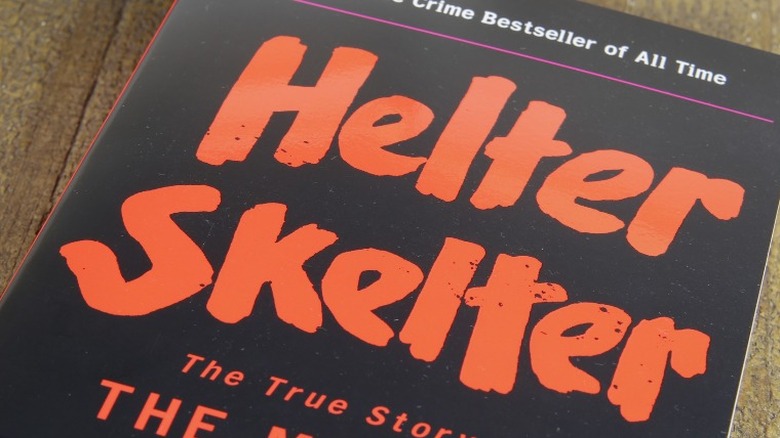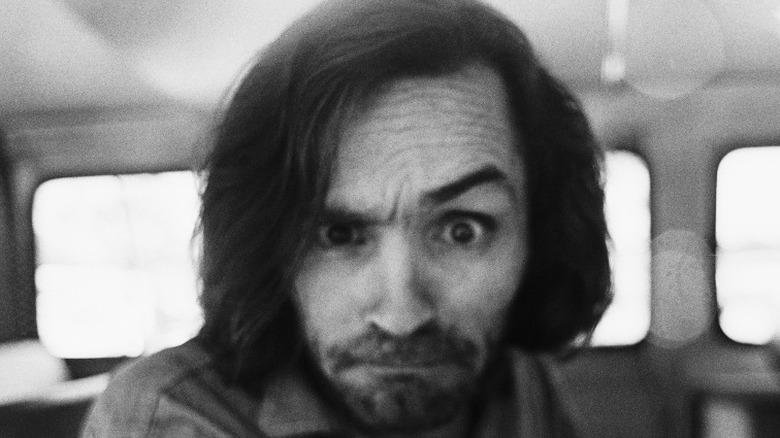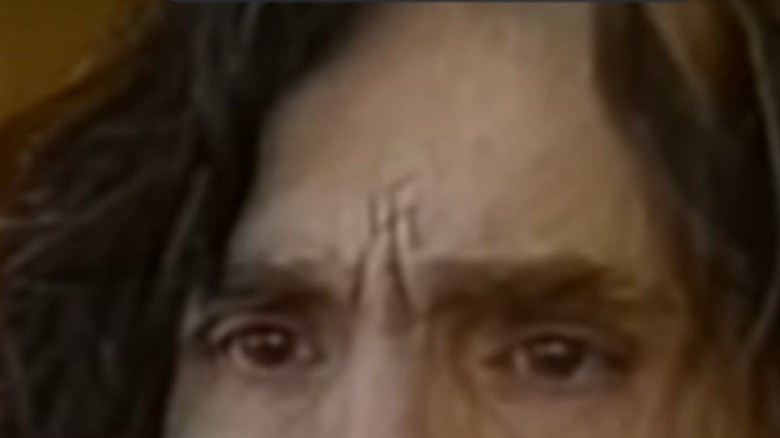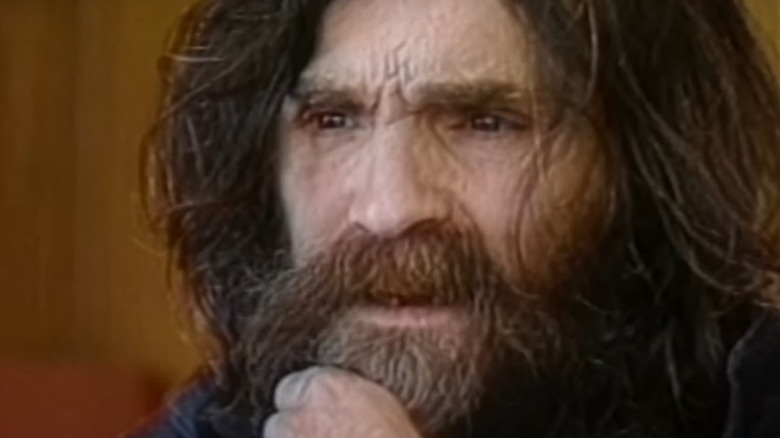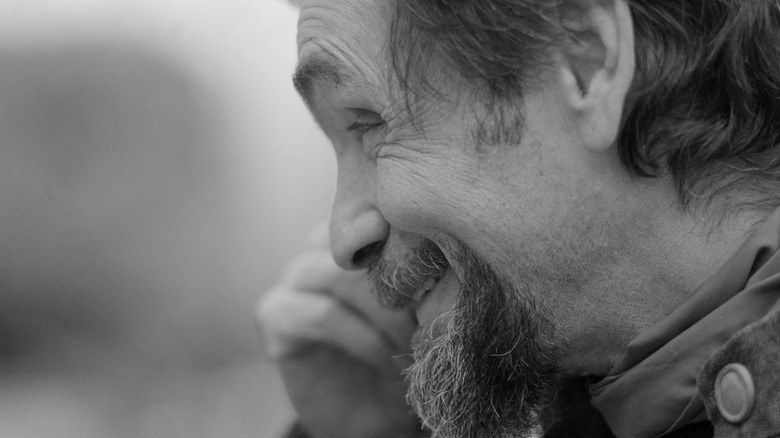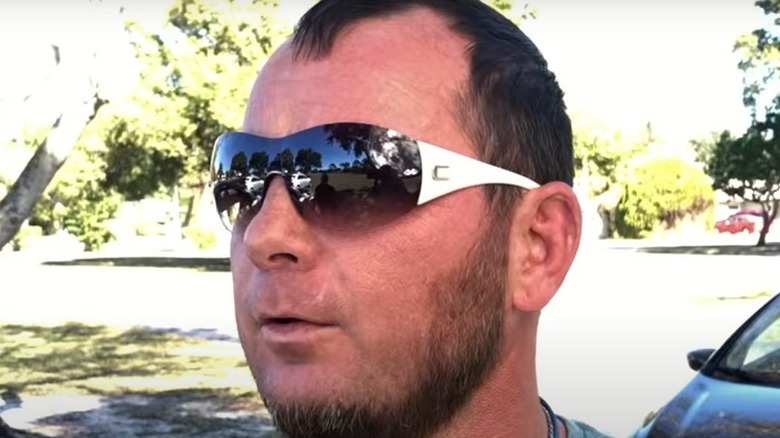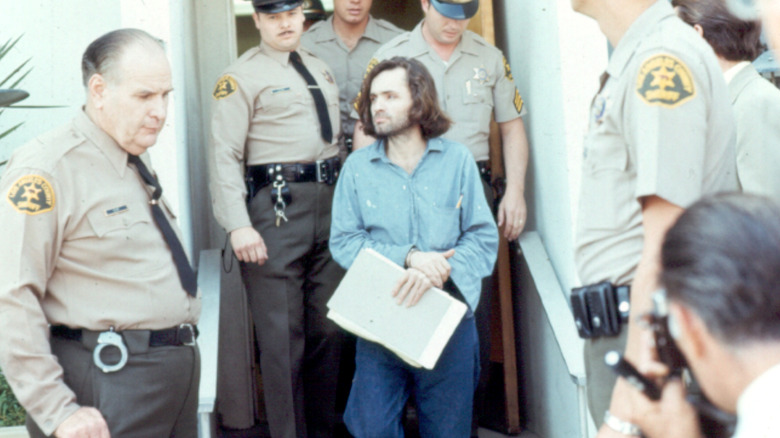The Untold Truth Of Charles Manson
When Charles Manson died on Nov. 19, 2017, the announcement was met with a puzzled sort of, "Huh." The world has held a strange fascination with Manson ever since the inner workings of his "family" went public after a string of grisly murders, all of which were done not by him but at his behest.
According to CNN, Manson was given nine life sentences, denied parole 12 times, and was elevated to something of a cult figure. He was the face of evil for most, though for some he was a wrongly convicted crusader. You can't get much more polarizing than that, and it's led to a continued fascination with the figure prosecutor Vincent Bugliosi described as a "dictatorial ruler of the (Manson) family, the king, the Maharaja." There's a lot that's come out about Charles Manson, his family, and his beliefs over the years, so let's buckle up and take a trip into the darkness.
Charles Manson's MO started when he was 6
The infamous killings happened in 1969, and it didn't take long for it all to be traced back to Charles Manson and the cult-like following he called "The Family." Writer and Manson biographer Jeff Guinn (via NPR) says Manson's fanatical ways started early. When he dug into Manson's childhood, he found that Manson inspired terrifying loyalty even he was wearing short pants and toddling around the schoolyard. Manson's cousin later said of him, "There was never anything happy about him. Never anything good about him."
He was 6 years old in first grade, and that was when he started with the same kind of manipulation that later escalated into murder. Guinn says he would talk to the girls in the class about other kids he didn't like, convincing them to go beat up the kids who had crossed him. When the principal confronted him, he used the same defense he would use in a courtroom decades later — "It wasn't me; they were doing what they wanted." If you've ever wondered if a child can be terrifying, there's the answer.
His early years were shaped by reform schools and horrible situations
It's human nature to want to know why something happened, especially when it's something this horrible. For years, people have looked for explanation in the early life of the man whose birth certificate listed him as "No Name Maddox," son of a 16-year-old girl who refused to name the father. According to The Los Angeles Times, the story told of Charles Manson's mother, Kathleen, was that she would leave him with relatives for weeks at a time and was a heavy drinker and robber who spent five years in state prison. When she was released, she and Manson traveled the country with a series of men he called his "uncles," until he ended up in a string of reform schools where he claimed to have suffered unthinkable abuse.
That's the accepted story, but when Jeff Guinn was given access to family documents and members for his book, "Manson: The Life and Times of Charles Manson," he says he found something else (via NPR). He says the stories — including Manson's tale about his mother's attempts to sell him for a pitcher of beer — were largely false. Guinn says Manson's mother loved him unconditionally, tried to keep him in school, and "loved him ... to the end of her life, her heart ached for things he did." That doesn't sound like the hateful mother Manson always went out of his way to describe — so clearly, something's not the truth.
The significance of Helter Skelter and the White Album
"Helter Skelter" was found written on the LaBiancas' fridge in blood — misspelled as "Healter Skelter" — and you've probably heard about Charles Manson's obsession with The Beatles. The whole story is ridiculously complicated, and Rolling Stone says Manson wasn't just obsessed with "Helter Skelter" but the entire "White Album."
Manson believed the album was an ode to a coming race war that would destroy the country with its epic proportions. During the trial, Manson and his followers claimed they had interpreted the "White Album" with help from the Book of Revelation, and it was especially powerful because it came on the heels of Magical Mystery Tour, which Manson believed documented his own hippie trip.
Manson assigned most of the songs an apocalyptic meaning — "Rocky Raccoon" was a clear racial slur, "Blackbird" was a fight against the establishment and a call for revolution, and "Piggies" was mocking the establishment. In case you're not intimately familiar with the "White Album," there are two other songs that don't need much in the way of explanation — "Revolution 1" and "Revolution 9." The Beatles have each individually expressed their horror at Manson's interpretation of the album, and George Harrison even condemned him for giving the scruffy, long-haired hippie look a bad connotation. It was John Lennon who put it best, though, simply saying, "He's barmy."
Charles Manson preached about the end of the race war
Charles Manson preached Helter Skelter was coming and when he said it, he meant it in a very literal sense. He — and, in turn, his followers — believed Helter Skelter was the name of a race war that would rip the country apart. The Miami Herald says he claimed white people would fight on two fronts — against each other and against Black people. That schism would be the deciding factor, and Manson preached that only he and his followers would be safe during the revolution. They were destined to retreat to Death Valley and live in an underground compound until he was sought out by the champions of Helter Skelter. That was, Manson said, destined to be Black people, who would need to find a new ruler.
You can probably guess who he thought that was going to be. He and his family were to be installed as the new leaders in a post-war world, and it was happening soon. He thought. The Beatles were the harbingers of the end of days, and that meant it was time to find the bottomless pit where he and his select few would wait out the war. When the war didn't start, he decided to accelerate the schedule a bit by sending his followers out to start killing.
Charles Manson's interpretation of the Book of Revelation
Where on Earth did Charles Manson get the basis for any of this? According to the UMKC School of Law, it was all rooted in his interpretation of the Book of Revelation. If you're not familiar with Chapter 9 of Revelation, that's the part of the Bible about opening "the pit of the abyss," fire and brimstone, the horses of the apocalypse, and the reign of Abaddon (angel of the abyss). It's heavy stuff whether you're a believer or not. Manson believed he was the fifth angel who held the key to the abyss, and that he would unlock it to literally unleash hell on the world.
He interpreted the entire section of the Bible to reflect his world, and of course, he was at the center of it. The locusts foretold to swarm the Earth were The Beatles, and references to their human faces and long hair ... well, let's just say it was pretty convincing to him. The fire and brimstone was their music, the so-called armies of horsemen were motorcycle gangs, and the abyss itself was in Death Valley. All that was left was for him to unlock the abyss and bring about the end of days. Just when you thought it couldn't get any darker.
His family had an uncomfortable relationship with the Beach Boys
Anyone who's asked to come up with a list of the most inoffensive groups in music history would almost certainly include the Beach Boys. But weirdly, in addition to their connection to surf, sand, and Kokomo, they're also connected to Charles Manson.
Specifically, it's drummer Dennis Wilson who had the Manson connection, and it started when, according to The Washington Post, Wilson picked up a few hitchhikers. They were part of Manson's Family and made introductions that led to Wilson crashing with The Family to enjoy some girls and even more drugs. Manson even taught him how to play a bit of guitar. Wilson was already riding high on fame, and the Manson clan moved in with him — until a vicious STD made orgies not as much fun anymore, and Wilson apparently footed the bill to get everyone cleaned up.
Wilson made the mistake of offering to help Manson with his dream of becoming a serious musician, but perhaps unsurprisingly, Manson didn't take well to the criticism that came with actually recording his music, and they parted ways. Fellow Beach Boy Mike Love suggested there might have been more to it than that, though, and wrote in his autobiography (via Mic) that Wilson had seen Manson actually kill a man. It's unconfirmed, but it wouldn't be entirely surprising. There's a lot about Manson's life story that's full of half-truths and outright lies.
He claimed he was the original writer of a Beach Boys song
Charles Manson relentlessly insisted there was more to his relationship with the Beach Boys, though. He claimed Dennis Wilson took one of his songs, turned it into "Never Learn Not to Love," and didn't even give him a writing credit.
Manson repeated the claim in the documentary, "Truth and Lies: The Family Manson" (via Rolling Stone), and added at the time, he was so insanely angry about it he went as far as leaving a bullet on Wilson's bed. There was no violence, though, as Manson was holding out hope Wilson would introduce him to producer Terry Melcher. It was a hope that would eventually lead to murder.
It wasn't the only time Manson would claim the Beach Boys stole his music, either. Rolling Stone says Manson also swore he originally wrote "In My Room" as "In My Cell," but the claim is absolutely impossible. Impossibility didn't stop Manson at other times, so why would that matter here?
10050 Cielo Drive and Sharon Tate
Any manipulative killer achieves a certain amount of notoriety, but part of the reason Charles Manson's name is still high profile is because of victim Sharon Tate. The wife of Roman Polanski and an up-and-coming actress, she ultimately met her horrible, horrible end because they had picked the wrong house.
After meeting up with Dennis Wilson and being promised a hook-up to producer Terry Melcher, Manson continued to hold out hope his music career was going to take off. When it didn't, the BBC says Manson targeted Melcher and sent his loyal followers out to kill everyone they found in the producer's home. He had since moved out, and Polanski had moved in with his wife.
Polanski was in Europe when four Manson Family members broke into the house and started killing. Tate — who was due to give birth in a matter of days — died, along with friends Jay Sebring, Wojciech Frykowski, and Abigail Folger. Even though the goal was to kick-start the race war Manson believed would lead to him being crowned king of the world and head of a new social order, getting revenge on Melcher would have been, to put it mildly, killing two birds with one stone.
He had a seriously insane list of rules violations during his prison time
No one would expect Charles Manson to be an angel behind bars, but according to the Los Angeles Times, he'd amassed somewhere around 100 rules violations by the beginning of 2017. As California correctional spokeswoman Terry Thornton put it, "Suffice it to say that he cannot be described as a model prisoner."
What exactly does that mean? The violations included things like bizarre outbursts and behavior, throwing hot coffee on prison staff, starting fights, trying to start a flood, and trying to start fires. He was caught several times with drugs, illegal cell phones, weapons (including a hacksaw blade), and catalogs that led staff to believe he was trying to order hot air balloons in a completely insane plan to escape.
His figurative middle finger to law enforcement started at his trial, when he stood up, assumed the pose of Christ on the crucifix, and refused to sit down. He also lunged toward the judge and declared, "In the name of Christian justice, someone should cut your head off." It sounds like a little LSD in his cell was the least of their worries.
Charles Manson's followers fanatically defended him as a crusader for the environment
Along the way, Charles Manson coined the term ATWA. It stood for air, trees, water, animals, and it was at the heart of the spiel he used to lure in some of the hippiest of hippies, even into the 21st century.
It's no secret Manson had a weird way with the ladies. His last conquest, Afton Burton (who went by Star, the name Manson gave her), called herself Manson's wife and claimed everything about Helter Skelter, the murders, and the race war was absolute bunk. Instead, her Manson was a crusader for the preservation of everything that existed on the planet — ATWA. She told CNN, "Charlie never believed in something called Helter Skelter. ... He never thought any of that stuff. That's ridiculous. That's crazy. ... The only thing that he's trying to manipulate people into doing is planting trees and cleaning up the Earth. He genuinely cares about that. He's nice to everyone. I've never seen him try to be manipulative. I've never seen any of that."
She wasn't the only one who followed him because of ATWA. CNN reported he continued to gain followers, like Burton, who flocked to his idea of ATWA for years after he was tried, convicted, and imprisoned.
He'd touch everyone on the nose
Erik Hedegaard interviewed Charles Manson for Rolling Stone in 2013, and it was plenty weird. Hedegaard said Manson stroked his arm at one point during the interview, and if that's not enough to give you the heebie-jeebies, nothing will. He also said Manson "reached out and bounced one of his fingers off the tip of my nose, fast as a frog's tongue, dart and recoil."
All right, there's the nightmare stuff. Manson explained, "I've touched everybody on the nose, man. There ain't nobody I can't touch on the nose. ... If I can touch you, I can kill you."
Charles Manson's care packages
Charles Manson will have been gone for decades before his figure stops being larger-than-life. When Erik Hedegaard interviewed him for Rolling Stone, Hedegaard also talked to superfan Afton "Star" Burton about what Manson was really like — you know, behind the crazy.
Burton said that four times a year, she was allowed to send Manson a care package. And what did someone like Manson really hope to find when he opened that package? His favorites were mundane, almost unnervingly so. He loved sunflower seeds, pumpkin seeds, roasted peanuts, vegetable soup mix, crackers, cough drops, tea, and protein bars, along with socks, tank tops, and shorts. Just for good measure, she also included guitar strings, because playing the guitar remained one of his favorite hobbies. It's true what they say — everyone needs a hobby.
Charles Manson believed he was Jesus (and immortal)
Charles Manson's delusions of grandeur didn't stop at claims he was going to be the head of a new world order. He had also convinced his followers he was Jesus. All he'd needed to do was hint at the possibility, Rolling Stone said, and his followers did the rest when they elevated him to a position of near divinity.
They completely believed it, too. In 1977, Family member Leslie Van Houten went on record (via CBC News) to say, "I think at one point I really believed he was Jesus Christ." Manson hinted that he not only believed it, but that he believed in everything that went along with it. According to The Independent, Manson called off his imminent marriage to Afton Burton in 2015, after it emerged she only wanted to marry him so she could put his body on display after his death. Apparently he didn't think that was cool (true, that's not cool), plus he fully believed he was immortal (false, he is really dead).
His actions kick-started the idea of victim's rights
At a glance, not much good came from Charles Manson's insane reign of terror. The Washington Post says there's silver lining, though, and people can thank Sharon Tate's mother and sisters for it.
After Tate's gruesome death, mother Doris Tate appeared at family member Charles Watson's parole hearing, and she spoke. She was heard, too, and her words were the first victim impact statement in the state. Tate's family campaigned tirelessly for what became the Victims' Bill of Rights in California that ultimately led to all states passing laws allowing victims to speak out during trials and parole hearings. Later, Tate sisters Patti and Debra took up the crusade to fight for victim rights — and to keep Manson and his Family behind bars.
And that's huge. Manson may have wanted to bring about a race war and lead humankind into the next era, but his actions allowed a grieving family to pave the way for countless victims to have their voices heard throughout the justice system. That's something worth remembering.
Just how smart was Charles Manson?
Those who study the phenomenon behind cults have revealed that the majority of their leaders share several key attributes. Narcissism is a key characteristic, one that helps them employ a definitive power imbalance between the leader and the followers. To attract and retain followers, a cult leader will typically need to have a magnetic personality, with a level of charisma that infects the inner circle of the cult. Referred to as "charisma by proxy," according to Janja Lalich, professor emerita of sociology at California State University, Chico, (via the Cult Education Institute), this makes it possible for the cult to grow above and beyond what the leader could achieve on their own. And while Psych Mechanics notes that cult leaders will have an intelligent structure of beliefs, a high IQ isn't among the 50 traits a cult leader typically possesses, as outlined by Joe Navarro, a former FBI counterintelligence agent, in Psychology Today by Joe Navarro.
One might still assume that a cult leader possesses a genius-level IQ, but that has certainly not been the case historically. And though Charles Manson scored above average on his intelligence tests, he was far from "genius" level.
According to Jeff Guinn in his book, "Manson," Charles Manson was first administered an IQ test when he was incarcerated at 16. His score of 109 is considered to be above average. Several years later, he was tested again at another facility and fared a bit better. This time Manson's score elevated to "high normal," at 121.
He was married multiple times
For what he eventually became, Charles Manson did seem to try and lead a somewhat normal life when he was younger. In 1955, he married Rosalie Jean Willis, a 17-year-old hospital worker (per Biography). The wedded bliss didn't last long, however. When Manson was incarcerated (again), Willis left him, taking their infant son with her. She later remarried.
After his release, he met Leona Stevens, a prostitute that went by the name "Candy," as per All That's Interesting. Manson acted as Stevens' pimp. When Manson was arrested on federal forgery charges, Stevens helped him get an early release. She lied to his parole officer and the judge about being pregnant in an attempt to get the system to release Manson so that they could wed. The ploy worked, and he was let out on parole. While free in 1959, Manson married Stevens and impregnated her. He also stole a car and drove across state lines with her, leading to their arrests. This time, Stevens refused to work her magic. She testified against him, getting her out of trouble and sending Manson back for yet another stint behind bars.
Manson was nearly hitched a third time. The Associated Press reports that he and long-time admirer Star Burton received a marriage license on November 7, 2014, from the King's County Recorder's office. However, according to Biography, the license expired, and the two never got married.
How many followers did Charles Manson have?
The fascination with Charles Manson that followed his 1969 arrest for the murders he will forever be associated with made him a household name. His notoriety landed him on the cover of Life Magazine, and images of the killer and his cult followers were seen almost nightly through lengthy court proceedings that drug on for over a year. The world got a great look at the man whose charisma and charm convinced multiple people to follow his instructions to kill. With someone who could have such a hold on people, it might not be difficult to imagine that he had developed quite a following in the months leading up to the Tate/LaBianca murders in August 1969.
Nestled just outside Los Angeles was the Spahn Movie Ranch, still owned and occupied by the elderly and retired rancher George Spahn. Manson took his followers there, where several of them worked odd jobs around the property (via Screen Rant). It was here that Manson allegedly planned the murders.
Biography reveals that Manson had amassed as many as 100 followers by the time of the arrests, though it doesn't detail how many lived on the property. In an interview with History, former Manson cult member Dianne Lake recalled that at times there were as few as 10-15 members living there.
Manson's most well-known followers were Susan Atkins, Tex Watson, Patricia Krenwinkel, and Leslie Van Houten, all of whom were originally sentenced to death, as per History.
Why Charles Manson didn't receive the death penalty
Charles Manson's fate appeared to be sealed following his 1971 conviction for seven counts of first-degree murder, as per History. Manson, along with followers Charles "Tex" Watson, Susan Atkins, Patricia Krenwinkel, and Leslie Van Houten, were all originally sentenced to death. But a 1972 court case set the wheels in motion for Manson and his cohorts to not only be spared the death penalty but would also make it possible for each of them to be paroled.
History tells us that in 1972, the California Supreme Court abolished the death penalty. In "The People vs. Anderson," the state's high court concluded that the penalty was cruel and unusual punishment. And even though the state's voters successfully reinstated capital punishment later that year by popular vote, a federal decision made it moot.
The case of "Furman vs. Georgia" determined that the death penalty was administered in many cases out of racial biases and abolished it until a state successfully could demonstrate through their legislative and judicial processes that a death sentence would not be "carried out in a capricious or discriminatory manner" (per Oyez).
This meant that Manson and four of his followers had their death sentences commuted to life. As California didn't have "life without parole" as a sentence until 1978, Manson and the gang would technically be free to pursue parole. Though both Leslie Van Houten and Patricia Krenwinkel have been up for parole multiple times, their attempts have been denied.
He carved an X into his forehead
Those who have seen Charles Manson in his post-conviction interviews will probably have noticed that he has a faint tattoo of a Nazi swastika on his forehead, just above his brow line. In his book about the Manson murders and the lengthy court trials, prosecutor Vincent Bugliosi details the roots of the tattoo. "Helter Skelter" revealed that Manson arrived at court one morning with an X carved into his forehead. It was freshly cut and still bleeding. The book gives Manson's explanation of the X, detailing an account of his followers passing out fliers in front of the courthouse with his written statement etched on them. "I have X'd myself from your world. You have created the monster. I am not of you, from you, nor do I condone your unjust attitude toward things, animals, and people that you do not try to understand."
Oxygen tells us that many of Manson's female followers (including Sandra Good, Squeaky Fromme, and Susan Atkins) followed suit and carved the letter into their foreheads.
While in prison for the Tate/LaBianca murders, Manson added to his X, tattooing small lines from the ends until it became the swastika that he was marked with until his death.
How did Charles Manson die?
Charles Manson died on November 19, 2017, just a week after his 83rd birthday. The Associated Press reports that he died of natural causes while staying in a California hospital. Jailed in 1969 for his hand in the Tate/LaBianca murders, Manson never again experienced freedom, being denied parole multiple times since his 1971 sentencing. Though Manson had lived a long life, nearly all of it had been spent behind bars, having garnered convictions and reformatory sentences since the age of 12 (per CNN).
Manson had been seriously ill in the months leading up to his death, according to reports from the Los Angeles Times. He had been taken from his cell in Corcoran State Penitentiary to Mercy Hospital in Bakersfield, California, for an illness that the medical provider refused to disclose to the media. Citing privacy and security reasons, prison officials also declined to reveal why Manson had been placed there.
He'd been involved in Scientology
Scientology has deep roots in Hollywood, with followers ranging from A-list celebrities like Tom Cruise and John Travolta to business magnates like Robert Duggan (per Forbes). As this cultural phenomenon was gaining traction in the 1960s, it might not be a surprise that even an incarcerated Charles Manson wasn't free from its influence.
Catholic Online reports that Manson was introduced to the practice while imprisoned in 1961 at the United States Penitentiary of McNeil Island, Washington. Attracted to what he considered to be "mind control tactics" of the church, Manson began to identify as a follower. He was first turned on to Scientology by his cellmate Lanier Rayner and underwent extensive auditing by a member of the church. At one point, however, Manson felt that these audits were too much for him to handle, reaching his breaking point with the church after undergoing an accumulative 150 hours of the process during his time in prison.
This didn't deter Manson's admiration for the tactics the church used, though. When he began to develop followers after his 1967 release from prison, he assigned cult member Bruce Davis to study the philosophy of Scientology abroad. Davis worked for the church in England, before being tossed out for his drug and alcohol habit (per Knoxville News).
Charles Manson had three sons
With the amount of "free love" that was happening at the Spahn Movie Ranch that Charles Manson and his cult used as headquarters, it might be difficult to determine how many of the children born there were sired by Manson. Records show, according to the Los Angeles Times, that a son born to cult follower Mary Bruner was fathered by Manson. The child, Valentine Michael, was raised by Bruner's parents and has stayed out of the public eye.
Before his days as a cult leader, Manson fathered two other children (via Newsweek). He was married briefly to Rosalie Jean Willis, who gave birth to Manson's first son, Charles Manson Jr. Wedded bliss didn't last long. Manson was arrested and sent to prison for car theft, prompting Willis to divorce him, as per Oxygen. She later remarried, and little Charlie took the name of his step-father, becoming known as Jay White. Sadly, White was unable to emotionally cope with being the son of someone as notorious as Manson and ended his own life in 1993, reports Newsweek. White had at least one child, a Florida-based MMA fighter named Jason Freeman. Freeman has fought bouts under the moniker "Charles Manson III" (per MMA News).
Manson also had a son with a woman named Leona "Candie" Stevens. Stevens was one of several women that Manson would pimp out and had a short-term but tumultuous relationship with (per Oxygen). She bore a son with Manson, named Charles Luther.
Who inherited Charles Manson's estate?
The claims against Charles Manson's estate might have been averted altogether if Star Burton would have been successful in her marriage attempt to Manson. Burton applied for and received a marriage license in November 2014, issued by the Kings County Recorders office. NBC News reports that this gave the couple a full 90 days to wed before the license expired. The New York Post learned that Manson allowed the license to expire when he learned that Burton was only attempting the legal binding of the two in an attempt to get possession of his corpse when he finally died. Planning on putting it on display, Burton schemed to make money by charging admission to see it. As his legal wife, the contents of his estate (amounting to little more than his prison possessions and various musical recordings, notes the Los Angeles Times) would have included the right to determine what happened to his remains.
With Manson still single when he died in 2017, several family members began vying for control of the estate. According to My News LA, this included a woman alleging to be the late convict's sister, Jason Freeman (his grandson), and long-time pen pal Michael Channels. Though ruled to be the offspring of one of Manson's three known sons in a 1986 court case, Freeman had to be officially certified as the cult leader's blood kin to have any real shot at claiming all or a portion of the estate. As of 2022, The Herald reports that a court awarded Freeman his grandfather's remains, but the heir is still in a legal battle over the remainder of the estate with Channels.
He was shorter than you may think
One of the questions about Charles Manson that has many left wondering on the internet is regarding his build. From all of the news media coverage surrounding his trial, it was fairly easy to ascertain that Manson was of smaller stature, sans a menacing figure that was capable of barking out commands to kill. Rachel Martin of NPR interviewed writer Jeff Guinn about Manson following his death in 2017. In the interview, Guinn remarked that Manson was short, standing at only 5 feet 2 inches. Claims about Manson measuring this height were repeated during Rolling Stone's 2013 interview with Manson's then-fiancé Star Burton, who claimed that Manson was at least three inches taller. Burton maintains that the man who successfully prosecuted Manson and his cohorts made the dubious statement about his height in his book "Helter Skelter." She insists that Vincent Bugliosi did this to make him seem smaller, perhaps to emasculate him.
On the subject of his height, Manson himself weighed in on at least one occasion. In a 1993 interview with Diane Sawyer, Manson becomes animated when he proclaims, "When I was arrested I was 5-foot-7. Then I went down to 5-foot-6, then I went down to 5 feet, then to 4 feet ... by the time that you all die I'll be down to about 3 feet tall." When directly asked by Sawyer, he said he stood at 5 feet 6 inches (per ABC News).
